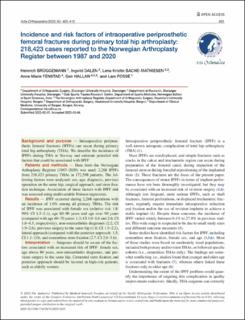| dc.contributor.author | Brüggemann, Heinrich | |
| dc.contributor.author | Dalen, Ingvild | |
| dc.contributor.author | Bache-Mathiesen, Lena Kristin | |
| dc.contributor.author | Fenstad, Anne Marie | |
| dc.contributor.author | Hallan, Geir | |
| dc.contributor.author | Fosse, Lars | |
| dc.date.accessioned | 2022-05-27T13:40:41Z | |
| dc.date.available | 2022-05-27T13:40:41Z | |
| dc.date.created | 2022-04-12T13:42:53Z | |
| dc.date.issued | 2022 | |
| dc.identifier.citation | Acta Orthopaedica. 2022, 93(2022), Side 405-412. | en_US |
| dc.identifier.issn | 1745-3674 | |
| dc.identifier.uri | https://hdl.handle.net/11250/2996521 | |
| dc.description | This is an Open Access article distributed under the terms of the Creative Commons Attribution-NonCommercial 4.0 International License (https://creativecommons.org/licenses/by-nc/4.0/), allowing third parties to copy and redistribute the material in any medium or format and to remix, transform, and build upon the material for non-commercial purposes, provided proper attribution to the original work. | en_US |
| dc.description.abstract | Background and purpose: Intraoperative periprosthetic femoral fractures (IPFFs) can occur during primary total hip arthroplasty (THA). We describe the incidence of IPFFs during THA in Norway and estimate potential risk factors that could be associated with IPFF
Patients and methods: Data from the Norwegian Arthoplasty Register (1987–2020) was used: 2,268 IPFFs from 218,423 primary THAs in 172,598 patients. The following factors were analyzed: sex, age, diagnosis, previous operation on the same hip, surgical approach, and stem fixation technique. Association of these factors with IPFF risk was assessed using multivariable Poisson regression.
Results: IPFF occurred during 2,268 operations with an incidence of 1.0% among all primary THAs. The risk of IPFF was associated with female sex (relative risk 1.8; 99% CI 1.5–2.1), age 80–90 years and age over 90 years (compared with age 60–70 years: 1.3; CI 1.0–1.6 and 2.6; CI 1.6–4.3, respectively), non-osteoarthritis diagnoses (2.2; CI 1.9–2.6), previous surgery to the same hip (1.8; CI 1.5–2.2), lateral approach (compared with the posterior approach: 1.5; CI 1.1–2.0), and cementless stem fixation (2.7; CI 2.0–3.6).
Interpretation: Surgeons should be aware of the factors associated with an increased risk of IPFF: female sex, age above 80 years, non-osteoarthritis diagnoses, and previous surgery to the same hip. Cemented stem fixation and posterior approach should be favored in high-risk patients, such as elderly women. | en_US |
| dc.language.iso | eng | en_US |
| dc.subject | intraoperative periprosthetic femoral fracture | en_US |
| dc.subject | IPFF | en_US |
| dc.subject | orthopedics | en_US |
| dc.subject | THA | en_US |
| dc.subject | total hip arthroplasty | en_US |
| dc.title | Incidence and risk factors of intraoperative periprosthetic femoral fractures during primary total hip arthroplasty: 218,423 cases reported to the Norwegian Arthroplasty Register between 1987 and 2020 | en_US |
| dc.type | Peer reviewed | en_US |
| dc.type | Journal article | en_US |
| dc.description.version | publishedVersion | en_US |
| dc.rights.holder | © 2022 The Author(s) | en_US |
| dc.source.pagenumber | 405-412 | en_US |
| dc.source.volume | 93 | en_US |
| dc.source.journal | Acta Orthopaedica | en_US |
| dc.identifier.doi | 10.2340/17453674.2022.2431 | |
| dc.identifier.cristin | 2017005 | |
| dc.description.localcode | Institutt for idrettsmedisinske fag / Department of Sports Medicine | en_US |
| cristin.ispublished | true | |
| cristin.fulltext | original | |
| cristin.qualitycode | 1 | |
